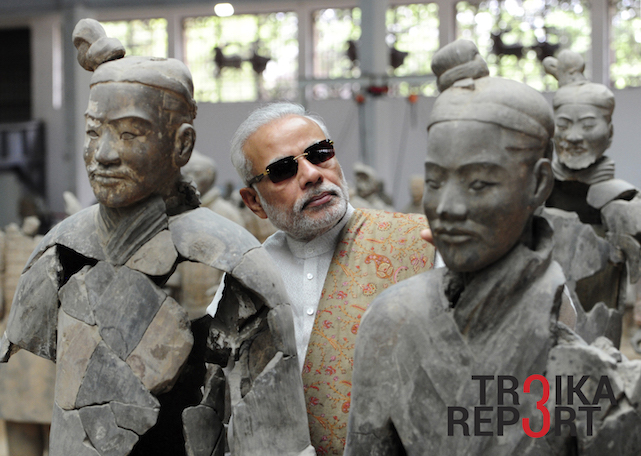Going Eastward

In this May 14, 2015 photo released by China's Xinhua News Agency, Indian Prime Minister Narendra Modi visits the Emperor Qinshihuang's Mausoleum Site Museum in Xi'an, capital of northwest China's Shaanxi Province. Source: AP
Foreign policy is often about symbols and perceptions, as explicitly proved by the recent visit to China by Indian Prime Minister Narendra Modi. The watershed event has opened a window of opportunity for an accelerated warming up of relations, and this is more than just good news for Russia.
Despite a bitter legacy of past conflicts and contemporary rivalry, Mr. Modi’s three-day tour sent a signal that the two powerhouses, with their high economic growth and home to a third of the planet’s population, have finally realized that the moment is ripe, if not overripe, to patch up old quarrels and join forces to shape the emerging “brave new Asia.”
The long-lasting animosity has roots in the border dispute dating back to 1914. Britain, the colonial master of India at the time, drew out the so-called McMahon Line, which was not accepted by China as a formal boundary. The border dispute eventually provoked a war in 1962, and its scars are still felt by both sides.
This time, Prime Minister Modi and China's Premier Li Keqiang have agreed to seek a “fair resolution” to border disagreements and let bygones be bygones. As Li pointed out, the two countries have “enough political wisdom to manage and control” differences, adding that “our common interests are far bigger than our differences.”
This step forward in relations between Delhi and Beijing was backed up by 21 signed agreements and MoUs estimated to be worth $22 billion. The envisaged cooperation covers a range of areas of mutual interest like manufacturing (steel and metals), power generation infrastructure, small & medium business, and the film and entertainment industry.
Both nations can benefit from the positive engagement. India has a huge appetite for foreign investments given Narendra Modi’s commitment to the grand vision of the “Make in India” policy, while China can tap the no less promising consumer market of India by adding it to its end-user list.
To assess the true value of Modi’s visit, Troika Report approached Brian Yeung, an independent financial analyst in Hong Kong, who says that it could become “a game changer in Sino-Indian relations and the world of emerging economies.” Here is what Yeung had to say:
“The past few years have seen an increasingly strained relationship between the two rising powers in Asia and their trade deficit soared from $1 billion in 2001-2002 to $38 billion last year. Measures to tackle trade deficit such as signing MoUs to improve market access topped the agenda for this visit.
“Given India's strategic importance to China's ‘One Belt, One Road’ initiative as well as the BRICS alliance, an improved economic partnership between China and India will carry significant implications for the world's economy. As the SCO and the BRICS summits are just two months from now, we are expecting a new golden age for the Asian economy and a brave new world defined by the Global East.”
A similar positive appraisal was made for Troika Report by Manish Chand, CEO and founder-editor-in-chief of the India Writes Network, who called the visit “a milestone” and predicted that it will chart “a roadmap for the long-term development” of India-China relations. Chand also placed it in a wider context:
“Overall, Prime Minister Modi’s visit, coming as it does barely months after Chinese President Xi Jinping’s visit, underscores the strategic intent of the two Asian giants to build up a narrative of win-win cooperation in shaping an Asian century, rather than the construct of rivalry, as conjured up in sections of the Western strategic circles and media.”
It is noteworthy, that on the eve of his departure for China, Modi phoned Russian President Vladimir Putin and confirmed his attendance of the Shanghai Cooperation Organization (SCO) summit in Ufa this July.
Since the SCO is evolving into a formidable union with enormous potential for growth, the dismantling of roadblocks in the turbulent relationship of the two Asian majors would serve as an impetus for further economic integration which, invariably, requires a high level of political coordination or at least putting aside differences. The India-China joint statement specifically noted that both sides intend to show “respect and sensitivity to each other’s concerns, interests and aspirations.”
Moscow has a big stake in smoothened interaction between Beijing and Delhi since it paves the way for molding a “triangle” of nations capable of playing a significant role in ensuring global stability.
Read the full version at RBTH.com.
All rights reserved by Rossiyskaya Gazeta.
Subscribe
to our newsletter!
Get the week's best stories straight to your inbox